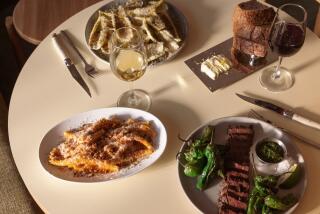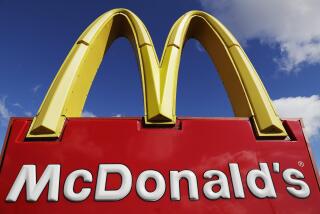When in Rome, Save Like a Roman : An insider shares her secrets for cutting costs on transportation, dining, shopping and sightseeing.
- Share via
ROME — As an American expatriate who has spent much time in Italy over the past decade, I have watched with alarm--and at times with horror--the combined effects on my pocketbook of inflation, unscrupulousness and wildly fluctuating exchange rates.
Less than a year ago, inflated prices and an extremely weak dollar had combined to make Italy one of the most expensive countries in Europe. Prices in Rome and other major cities were as breathtaking as their incomparable art and architecture.
Today, a sharp devaluation of the Italian lira, as well as the tightening effect of a countrywide recession, have eased the situation considerably for American visitors. But in many respects, Italy is still no bargain: It costs 80 cents or more, for example, to send a letter back to the United States; “moderate” restaurants are described in a leading local guide as those whose meals cost “under $30 for one”; gasoline runs more than $4 a gallon. You can easily spend $10 or more for a sandwich and beer at a sidewalk cafe.
The survival instinct has taught me, over the years, a number of tips on how to stretch my money. Many of these can be helpful to visitors, and some general rules apply to traveling in other European countries.
Some money-saving maneuvers can be taken care of even before you leave home.
For example, you will save considerable money by booking your rent-a-car from the States. If you rent one in Italy on the spot, it can cost more than $100 a day for even a tiny subcompact.
Bring with you any cosmetics and medicines--even aspirin--you might need. Everything is available in Italy, but there is no such thing as a big, cut-rate drug store or discount generic prices. Medications must be purchased in pharmacies, where simple aspirin costs more than $3 for a package of 24 tablets. Even condoms can cost up to $1.30 apiece. Likewise, bring guidebooks and other reading matter with you. You can buy English-language books and magazines at bookstores and newsstands, but a simple paperback mystery can run you over $10. Guidebooks to Italy published in the U.S. or England cost about twice their cover price at home.
Get a long-distance calling card such as AT&T;, MCI or Sprint in order to make calls home. Direct dialing from Italy to the States costs about $3 a minute--even more if you call from your hotel room where you are subject to extra charges. Calls charged on your long-distance card cost one-third to one-half the direct-dial Italian price. (Long-distance access numbers are printed daily in the International Herald Tribune.)
Aside from hotels, main tourist expenses in Rome include getting around, eating, sightseeing and shopping--and there are ways to save money on all of these.
TRANSPORTATION
A taxi into Rome from Leonardo da Vinci Airport at Fiumicino will cost about $50 for the 30- to 45-minute ride. But a train into town costs only $4. Transport can be difficult from the downtown terminal (Ostiense), however: The nearest subway (Metro) station is a bit of a hike if you have luggage, and bus and taxi service from the terminal can also be erratic.
If a taxi does come along, bear in mind that it costs more than $4 just to get inside a Roman taxi. The meter only starts running after 3 kilometers, which makes a short trip very expensive. And you now must pay an extra 1,500 lire ($1) if you take a taxi on Sunday, and an extra 1,000 lire (67 cents) for each bag you put in the cab’s trunk.
Public transportation is one of the only bargains in Rome. Bus tickets cost about 60 cents each, and the same ticket can be used on any number of buses within a 90-minute period. Subway tickets also cost under $1, and you get a discount if you purchase 10 at a time.
DINING
Restaurant food and other refreshments can be outrageously expensive in Rome, but there are still ways to manage.
First and foremost: Don’t sit down . That is, don’t sit at a table where you are served by a waiter. Table service at a bar or cafe can double or triple the cost of your caffe , cappuccino , tramezzino (sandwich) or campari soda . Most bars and cafes display a price list behind the cashier’s desk that lists costs both at the bar and the table. Check these. I once forgot to look and ended up paying $10 for two thin sandwiches and a beer.
At a number of cafes you can pay for your drink or sandwich at the cashier, then carry it yourself to a table for no extra charge. (There’s usually no sign, so ask the cashier if this is the policy.)
As far as sit-down restaurants go, look at the menu before you order. Many restaurants display their menu on the door or window. Until recently, all restaurants added a cover charge to the bill, a coperto usually noted at the top or bottom of the menu. In “moderate” restaurants, it usually runs between 1,500 and 3,500 lire ($1 to $2.33) a person. But this summer, to encourage business, about 100 Roman restaurants decided to do away with the coperto ; this is indicated on their windows.
In most Roman restaurants everything is ordered a la carte. Main dishes rarely come with a salad, vegetable or other garnish, so side dishes must be factored in. Some restaurants offer complete “tourist menus” at reduced prices. Don’t take the quoted price for granted: Some tourist menus include a cover charge and drinks in the price, others don’t. This may be listed on the menu, but it’s best to ask.
Restaurants are required by law to give you a formal bill--which you, by the way, are legally required to carry with you out of the restaurant. Don’t hesitate to compare everything on your bill with the prices listed on the menu, or to add up the figures given by the waiter. Question anything you don’t understand; every summer, newspapers run stories of tourists charged ridiculous sums by unscrupulous proprietors.
An increasing number of cheaper alternatives to normal sit-down restaurants do exist now in Rome. These make particular sense if you just want a salad or light meal.
Beer halls ( birrerie ) and pizzerias, for example, usually cost a lot less than other restaurants, although most sit-down pizzerias are only open evenings. Even in a simple pizzeria you can easily end up paying $20 or more apiece.
One of my favorite pizzerias is on Viale di Trastevere, just beyond Piazza Sonnino in the picturesque Trastevere district of Rome (look for a sprawl of sidewalk tables just beyond the McDonald’s). Locals know it as “The Morgue” because its tables are made of marble slabs, but its pizza is excellent. I also like the Birreria Tempera on Via San Marcello, just off Piazza dei Santi Apostoli near Piazza Venezia in downtown Rome. It can be crowded, but there is a good selection of salads and other light fare at lunch. All day long you can buy slices of pizza, sold by weight, from the innumerable little pizza bakeries advertising pizza rustica . These shops sometimes have informal seating, and many of them offer a dozen or more types of pizza, calzone and other finger food, such as suppli (rice balls). My favorite is Pizza’s House, at the Ottaviano Metro stop near the Vatican.
A rosticeria --a cross between a take-out and a cafeteria--is also a good place to eat less expensively. Located throughout the city, many offer a beautiful selection of hot and cold food displayed on counters on in windows. They can be very crowded at lunch. Franchi, at the corner of Via Cola di Rienzo and Via Fabio Massimo, near the Vatican and Castel Sant’Angelo, is one of the most elegant. Delfino is another, located on Largo Argentina in the heart of downtown Rome.
Fast-food restaurants have taken off in Rome, partly because of their lower prices. The McDonald’s near the Spanish Steps has one of the best salad bars in the city, as well as the usual burgers and fries. Homegrown Italian fast-food outlets like Big Burg and Italy & Italy also serve quick pastas, salads and sometimes pizza.
Sandwich bars (paninoteche) , offering a wide variety of imaginative sandwiches, have sprung up in some Rome neighborhoods, particularly in the old town center. You can also go into almost any little grocery store and ask them to make you up a sandwich with fresh-cut cheese, salami or what-have-you; you pay what you would if you were buying the sandwich components as groceries. (In Milan, sandwich culture has reached far greater heights, and you can eat well at reasonable prices in the dozens of special sandwich shops.)
SHOPPING
A year ago it would have been tempting to advise potential shoppers to simply forget Rome and buy everything at home. But the drop in the lira has made Italian clothes and other goods much more affordable. Shoes, in particular, are again a decent buy.
To get the most for your money, try one of the few designer discount outlets. There are two good ones near the Vatican, close to each other on Via Germanico.
Gran Bazaar (136/138 Via Germanico) sells a variety of clothes for men, women and children--most with the labels cut out--in a real bargain-basement atmosphere. It specializes in casual and ski wear. (I recognized Max Mara ready-to-wear, but you have to dig through piles to find a treasure.) Vesti A Stock, two blocks down the street, generally has a much better selection, and the labels are left on so you know if you are looking at an Armani, Mondi or Krizia. The salespeople are very pleasant, and at end-of-season sales you can get some great bargains.
(In Milan, shoppers should invest $20 and pick up the invaluable paperback “Bargain Hunting in Milan” by Dorrie van Meurs. It’s a detailed guide to designer outlets, bargain basements, markets and other discount shopping, published in English and Italian.)
As in the States, because of Italy’s deepening recession there are many more sales than ever. In Rome, certain shopping streets are famous for their bargains. These include Via dei Giubbonari, near the colorful Campo dei Fiori market in the old city center, and Via Ottaviano, near the Vatican.
SIGHTSEEING
Sightseeing and entertainment also can be expensive in Rome, but some of the most enjoyable things in the city are still free.
Museum entrance fees may be as much as 10,000 lire ($6.70), but the city’s hundreds of churches are free and contain some of Italy’s most outstanding artwork. The many concerts held in churches are generally free, as are the beautiful parks on the Janiculan Hill and at the Villa Borghese. And it doesn’t cost anything to people-watch at the Spanish Steps or Piazza Navona.
If you don’t want to pay the entrance fee at ancient Roman sites such as the Forum, you can see quite a bit from outside.
And it still doesn’t cost anything to enjoy a stroll through the city at night, when many of the fountains and other architectural treasures are lit up and streets and piazzas glow with a magic that’s, well, eternal.
More to Read
Sign up for The Wild
We’ll help you find the best places to hike, bike and run, as well as the perfect silent spots for meditation and yoga.
You may occasionally receive promotional content from the Los Angeles Times.






